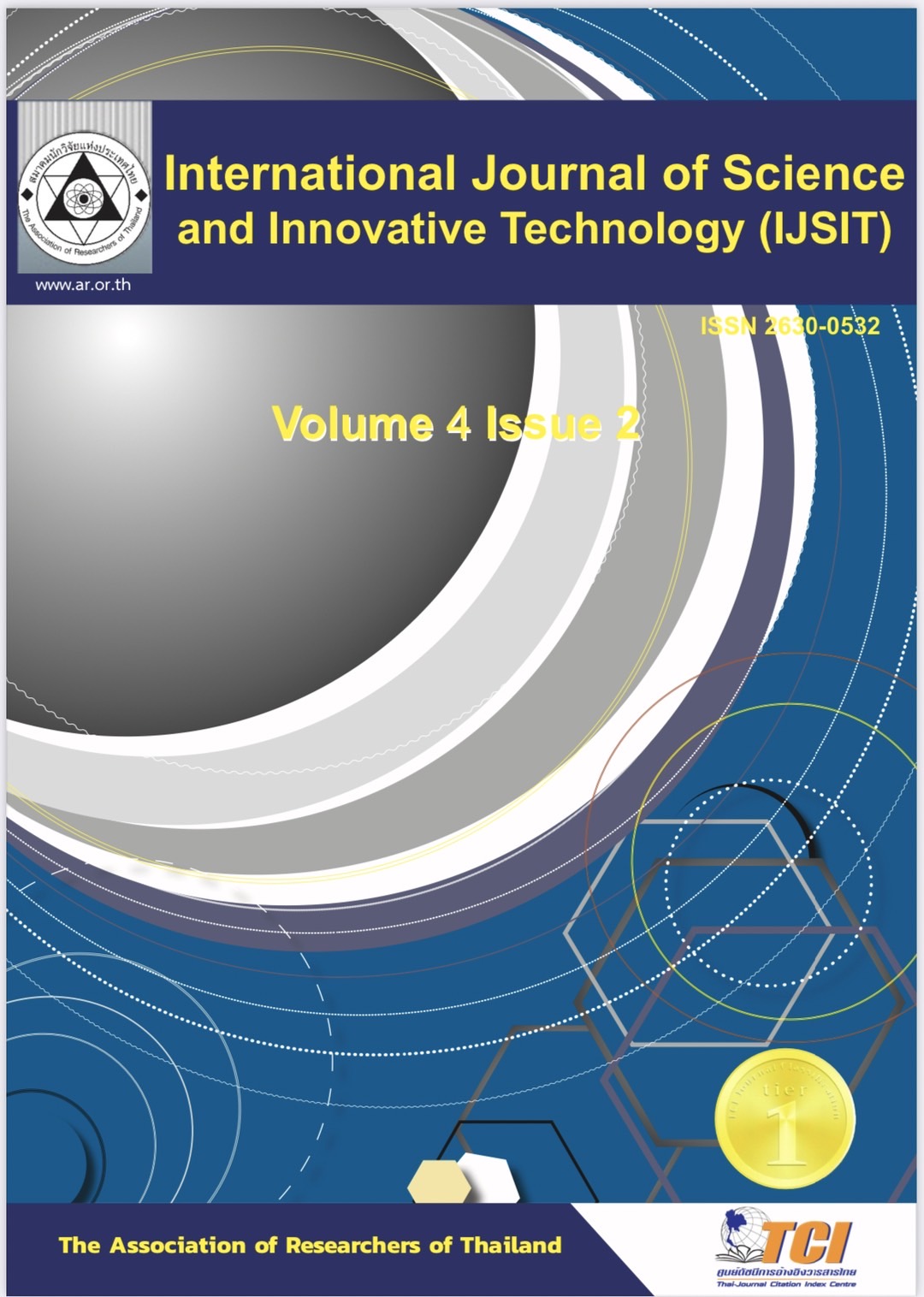A study on properties of fly ash-rice husk ash based geopolymer using recycled waste glass as fine aggregate
Main Article Content
Abstract
This research studied the compressive strength and fire resistance of geopolymer mortars using waste glass as a partial fine aggregate replacement. Fly ash (FA) and rice husk ash (RHA) that were the starting materials synthesized with a liquid alkali activator, is a mixture of 10 molar sodium hydroxide and sodium silicate solutions. Rice husk ash was used to replace fly ash at percentages of 0, 10, 20, 30, 40, and 50 by weight. Waste glass was ground to obtain sand-like particle sizes. Sand substitution with waste glass at 20% by weight was prepared. The results indicate that the workability and compressive strength of mortars decreased with an increase in rice husk ash content. The strengths of fly ash-rice husk ash geopolymer mortars at 28 days were in the range of 34 to 59 MPa, which are acceptable for some engineering applications. The geopolymer mortars retained their shapes up to 1,000°C that suitable for high temperature applications.
Article Details
References
Ali, E.E., Al-Tersawy, S. H. (2012). Recycled glass as a partial replacement for fine aggregate in self-compacting concrete. Construction and Building Materials, 35, 785-791.
Batayneh, M., Marie, I., Asi, I. (2007). Use of selected waste materials in concrete mixes. Waste Management, 27, 1870-1876.
Bhowmick, A. Ghosh, S. (2012). Effect of synthesizing parameters on workability and compressive strength of fly ash based geopolymer mortar. International Journal of Civil and Structural Engineering, 3, 168-177.
Chindaprasirt, P., Chareerat, T., Hatanaka, S., Cao, T. (2011). High strength geopolymer using fine high calcium fly ash. Journal of Materials in Civil Engineering, 23, 264-270.
Davidovits, J. (1991). Geopolymers-Inorganic polymeric new materials. Journal of Thermal Analysis, 37, 1633-1656.
Davidovits, J. (2008). Geopolymer Chemistry and Applications. Institut Géopolymère, Saint-Quentin, France.
Della, V.P., Kuehn, L., Hotza, D. (2002). Rice husk ash as an alternative source for active silica production. Materials Letters, 57, 818-821.
Detphan, S. Chindaprasirt, P. (2009). Preparation of fly ash and rice husk ash geopolymer. International Journal of Minerals, Metallurgy and Materials, 16, 720-726.
Duxson, P., Fernandez-Jimenez, A., Provis, J.L., Lukey, G.C., Palomo, A., van Deventer, J.S.J. (2007a). Geopolymer technology: the current state of the art. Journal of Materials Science, 42, 2917-2933.
Duxson, P., Provis, J.L., Lukey, G.C., Mallicoat, S.W., Kriven, W.M., van Deventer, J.S.J. (2005a). Understanding the relationship between geopolymer composition, microstructure and mechanical properties. Colloids and Surfaces A Physicochemical and Engineering Aspects, 269, 47-58.
Erdoğan, S.T. (2011). Use of perlite to produce geopolymer. Proceedings of the 31st Cement and Concrete Science Conference, Imperial College London, United Kingdom
Federal Highway Administration. (2017). Fly ash facts for highway engineers. [Online]. Available: https://highways.dot.gov/ (February 06, 2021)
Haddad, R.H., Ashteyat, A.M., Lababneh, Z.K. (2018). Producing geopolymer composites using oil shale ash. Structural Concrete, 1-11.
Hager, I. (2013). Colour change in heated concrete. Fire Technology, 1, 1-14.
Kroehong, W. (2012). Effect of rice husk ash and palm oil fuel ash on microstructure and chloride penetration of blended cement pastes. PhD Thesis, Suranaree University of Technology, Thailand
Matalkah, F., Aqel, R., Ababneh, A. (2020). Enhancement of the mechanical properties of kaolin geopolymer using sodium hydroxide and calcium oxide. Procedia Manufacturing, 44, 164-171.
Pan, Z., Sanjayan, J.G., Rangan, B.V. (2009). An investigation of the mechanisms for strength gain or loss of geopolymer mortar after exposure to elevated temperature. Journal of Materials Science, 44, 1873-1880.
Provis, J.L., van Deventer, J.S.J. (2009). Geopolymers: Structures, processing, propertiesand industrial applications. Woodhead Publishing and CRC Press, USA.
Real, C., Alcala, M.D., Criado, J.M. (1996). Preparation of silica from rice husks. Journal of the American Ceramic Society, 79, 2012-2016.
Sathawane, S.H., Vairagade, V.S., Kene, K.S. (2013). Combine effect of rice husk ash and fly ash on concrete by 30% cement replacement. Procedia Engineering, 51, 35-44.
Sinsiri, T., Teeramit. P., Jaturapitakkul, C., Kiattikomol, K. (2006). Effect of finenesses of fly ash on expansion of mortars in magnesium sulfate. Science Asia, 32, 63-69.
Solouki, A., Viscomi, G., Lamperti, R., Tataranni, P. (2020). Quarry waste as precursors in geopolymers for civil engineering applications: a decade in review. Materials (Basel), 13, 3146.
Stroeven, P., Bui, D.D., Sabuni, E. (1999). Ash of vegetable waste used for economics production of low to high strength hydraulic binders. Fuel, 78, 153-159.
Warnphen, H., Supakata, N., Kanokkantapong, V. (2019). The reuse of waste glass as aggregate replacement for producing concrete bricks as an alternative for waste glass management on Koh Sichang. Engineering Journal, 23, 43-58.
Wattanapornprom, R. Stitmannaithum, B. (2015). Comparison of properties of fresh and hardened concrete containing finely ground glass powder, fly ash, or silica fume. Engineering Journal, 19, 35-48.


